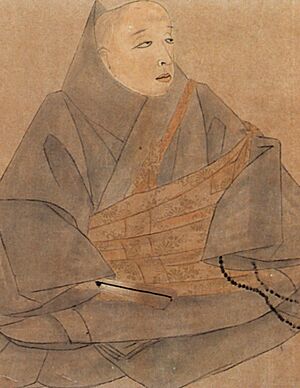Emperor Hanazono facts for kids
Quick facts for kids Emperor Hanazono花園天皇 |
|||||
|---|---|---|---|---|---|
 |
|||||
| Emperor of Japan | |||||
| Reign | 11 September 1308 – 29 March 1318 | ||||
| Coronation | 29 November 1308 | ||||
| Predecessor | Go-Nijō | ||||
| Successor | Go-Daigo | ||||
| Shōgun | Prince Morikuni | ||||
| Born | 14 August 1297 | ||||
| Died | 2 December 1348 (aged 51) Heian-kyō, Ashikaga shogunate |
||||
| Burial | Jirakūu-in no ue no Misasagi (十樂院上陵) (Kyoto) | ||||
| Issue | See below | ||||
|
|||||
| House | Yamato | ||||
| Father | Emperor Fushimi | ||||
| Mother | Tōin Fujiwara | ||||
| Signature | |||||
Emperor Hanazono (花園天皇, Hanazono-tennō, 14 August 1297 – 2 December 1348) was the 95th emperor of Japan. He ruled from 1308 to 1318.
Contents
Becoming Emperor
Before he became emperor, his personal name was Tomihito-shinnō. This means "Prince Tomihito."
He was the fourth son of Emperor Fushimi, who was the 92nd Emperor. Hanazono belonged to a special branch of the Imperial Family called the Jimyōin-tō.
Important Dates
- 1308: Emperor Go-Nijō, Hanazono's second cousin, passed away at age 24.
- 1308: Prince Tomihito became the new emperor. This event is called senso.
- 1308: Soon after, Emperor Hanazono officially took the throne. This is known as sokui.
- 1308: The name of the era changed to Enkyō to mark Emperor Hanazono's rule.
Ruling Japan
During Emperor Hanazono's reign, his father, the retired Emperor Fushimi, still had a lot of power. His older brother, the retired Emperor Go-Fushimi, also had influence. They were known as "cloistered emperors."
At this time, there were two main branches of the Imperial Family who both wanted to rule. They were called the Jimyōin-tō (Hanazono's family) and the Daikakuji-tō.
The government, called the Bakufu, helped them make an agreement. They decided that the two families would take turns ruling Japan every 10 years. This was called the Bumpō Agreement.
However, this agreement did not last long. The next emperor broke the rules that had been set.
Life After the Throne
In 1318, Emperor Hanazono stepped down from the throne. He gave up his position to his second cousin, Emperor Go-Daigo. Go-Daigo was from the Daikakuji-tō family.
After he stopped being emperor, Hanazono helped raise his nephew, Emperor Kogon. Kogon would later become a "Northern Pretender" during a time when Japan had two imperial courts.
In 1335, Hanazono became a Buddhist monk. He joined the Zen group of Buddhism. His old palace was turned into a temple called Myōshin-ji. Today, Myōshin-ji is a very large network of temples in Rinzai Buddhism.
Many places in the area are named after him, like Hanazono University and Hanazono Station.
Emperor Hanazono passed away in 1348. His imperial tomb, where he is buried, is called Jurakuin no ue no misasagi. It is located in Higashiyama-ku, Kyoto.
His Talents and Writings
Emperor Hanazono was very good at writing waka poems. He was an important member of the Kyōgoku School, a group known for their poetry style.
He also kept a diary called Hanazono-in-Minki. This diary recorded his thoughts and events during his time as emperor and after. He was a very religious and educated person. He always made sure to say his prayers to the Amitabha Buddha.
Important Officials
The Kugyō were a small group of the most powerful men in the Emperor's court. Even when the court didn't have much power outside the palace, these positions were still very important.
This elite group usually had only three or four men at a time. They were often from noble families and had a lot of experience. During Hanazono's reign, some of the top officials included:
- Sesshō (Regent): Kujō Moronori (1308)
- Sesshō (Regent): Takatsukasa Fuyuhira (1308–1311)
- Kampaku (Chief Advisor): Takatsukasa Fuyuhira (1311–1313, 1315–1316)
- Kampaku (Chief Advisor): Konoe Iehira (1313–1315)
- Kampaku (Chief Advisor): Nijō Michihira (1316–1318)
Eras During Hanazono's Reign
In Japan, years are grouped into special periods called nengō. Emperor Hanazono's reign included several of these eras:
Family
Emperor Hanazono had several children.
- Consort: Ogimachi Michiko (later Senkomon'in)
- Imperial Princess Hisako (1318–1358): She married Emperor Kogon.
- Imperial Prince Nobunaga (1327–1353): He later became a priest.
- Imperial Prince Naohito (1335–1398)
- Imperial Princess Noriko (died 1348)
- Priest Shōgoin
- A daughter who married into the Kazan'in family.
- Consort: Ichijo-no-Tsubone (died 1325)
- Imperial Prince Priest Kakuyo (1320–1382)
- Lady-in-waiting: Wamuro Yoriko
- Imperial Princess Noriko: She became a nun.
- Another Princess
See also
 In Spanish: Hanazono Tennō para niños
In Spanish: Hanazono Tennō para niños
- Emperor of Japan
- List of Emperors of Japan
- Imperial cult
- Emperor Go-Hanazono


